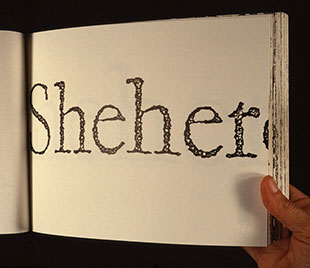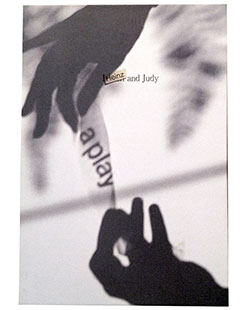|
|
|
Janet Zweig~
New York |
Share this page: |
| |
|
Bio: “Janet Zweig is an artist who lives in Brooklyn, NY, working primarily in the public realm. Her public works include a gate to fictional locations at the Austin Airport, a kinetic installation on a pier on the Sacramento River, a performance space in a prairie on a Kansas City downtown green roof, a generative sentence on a wall in downtown Columbus, a sentence-generating sculpture for an engineering school in Orlando, a 1200' frieze at the Prince Street subway station in New York, and a system-wide interactive project for eleven Light Rail train stations in Minneapolis, incorporating the work of over a hundred Minnesotans. Her sculpture and books have been exhibited widely in such places as the Brooklyn Museum of Art, Exit Art, PS1 Museum, the Walker Art Center, and Cooper Union. Awards include the Rome Prize Fellowship, NEA fellowships, and residencies at PS1 Museum and the MacDowell Colony. She currently has a residency with the New York City Mayor's Office of Climate and Sustainability. She teaches at the Rhode Island School of Design and Brown University." |
|
This Book is Extremely Receptive
By Janet Zweig
Long Island, New York: Janet Zweig, 1989.
15 x 16 cm; 144 unnumbered pages. Flip book. Telephone dialogs by Holly Anderson. Computer error messages transcribed from Digital computer system. Television text transcribed from “The Burns and Allen Show, “The Honeymooners”, “The Love Connection”, “The New Newlywed Game”, and “The Peoples’ Court”. Generated on a Macintosh personal computer. Printed at Pyramid Atlantic, Washington DC by Brad Freeman. Sewn signatures glued into a reflective silver paper wrapper. Bound by Mueller Trade Binder, Middletown, CT.
Janet Zweig: "’This Book is Extremely Receptive’ is about misunderstanding in the age of telecommunications. It is a flip book with several ongoing threads. There are three continuous texts: computer error messages, excerpts from sit-coms featuring misunderstandings, and humorous stories of misunderstandings written by Holly Anderson. Using one of the first available 3-D modeling programs, Zweig makes a satellite dish turn throughout the book, as if looking for information to receive. There are also three different wavelengths accompanying the texts that wiggle through the pages as you flip them.”
Judith Hoffberg, Umbrella, Vol. 12, No. 2, December, 1989: “This book is extremely receptive” a flipbook with dialogs by Holly Anderson. This flipbook when rifled works as a circling satellite dish searching the airwaves picking up misunderstandings and miscommunications from telephone television and computer networks. When you flip the book the satellite dish keeps whizzing around. But the next step in manipulating the book is to read it. First you can read the telephone conversations … Some inept inane but quite real revealing wrong numbers bad connections and even other misunderstandings. Then the computer lingo may get you being formal and structured coming from the commands issued by a digital computer frustrating the user. Creating fatal errors among other sins an illegal character appears transmission is aborted. The third line of text comes from television programs … Yes this book is extremely receptive to any and all who realize that our everyday lives are controlled by technology. Which is frightening abstract yet even funny.”
Johanna Drucker, The Century of Artists’ Books, pages 257-258: “The way in which sequence is articulated gives each book its unique identity. A sequence can be made to move very quickly – the flip book is the extreme of this, but there are other sequences which have either very little resistance or else a great deal of momentum and thus move rapidly. In ‘This Book is Extremely Receptive’ … Janet Zweig and Holly Anderson incorporate the image of a turning satellite dish as a flip book motif on the lower right corner whose momentum is graphically reinforced by images of sound waves. The typographic text appears to move very quickly through this field, also generating the sensation of a fast moving book.”
$150 |
|
| |
|
| |
|
Sheherezade
A flip book by Janet Zweig, with text by Holly Anderson.
Boston, MA: Photographic Resource Center, 1988.
18 x 23 cm; 320 unnumbered pages. Printed on Mohawk Superfine paper for the text. Sewn signatures adhesive-bound into an illustrated purple paper wrapper with title stamped in gilt on front of wrapper and on spine.
Janet Zweig: "The 9th Century character in the 1001 Nights, told stories within stories in order to save her own life. ‘Sheherezade, the flip book’, is an exploration of recursion, of things within things. Zweig asked the writer Holly Anderson to write five stories, each nested within the next, about women revealing or withholding information. The book flips to reveal each story inside the letterforms of the previous story. The unique spelling of the name is meant to unfold the phrases: ‘She here,’ ‘She her,’ ‘She he,’ ‘She,’ successively. On the left page corners, a woman takes off her dress and throws it out of the book, to reveal the same dress underneath for five iterations.
“Technically the book was produced using three different print technologies. First, Zweig printed the five stories in letterpress. Then she used a Xerox machine to blow up the stories until they broke apart into fractal-like patterns. Then she photographed these images successively and made film for offset lithography in which the final books were printed.”
Judith Hoffberg, Umbrella, Vol. 11, No. 1, September, 1988: “’Sheherezade’ by Janet Zweig with text by Holly Anderson is a most unusual flipbook which adds a new dimension to the genre. In addition to the magical narrative digressions of the original ‘Sheherezade’, the type digressions become an element unto themselves. As you open the book the title is progressively enlarged page by page until it becomes a blow-up distortion of a black net. Thus. revealing in five episodes short narratives which begin very small and progressively enlarge to reveal the text and then get so big that they disappear off the page swallowing up itself and thus revealing the next text. The texts are printed on the recto while on the verso a small female figure in the left hand corner quickly divests herself of a different piece of clothing each time the narrative changes. In fact each time a new narrative comes into view we find this female figure standing still and straight. Her removal of clothing over her head reminds one of Hugo Largo's lead singer who also removes one piece of clothing after another each time she sings a new number. Much like a fugue with two tempi this book distracts and intensifies at the same time making it necessary to return to the beginning of the book after immersing ourselves into the net in which the book metaphorically involves us.”
Johanna Drucker, “The Century of Artists’ Books”, Scale and Progression pages 248-250: “There are verbal works which use dynamic transformations, either of scale or of a progressive sequence, as aspects of linguistic meaning. One such work is the collaboration ‘Sheherezade’ … produced by Janet Zweig and Holly Anderson. Here, the theme of the embedded narrative takes graphic form. The story of Sheherezade, the woman whose life depends upon her narrative ability … is shown as a movement from one story to another as if they were literally embedded in each other . The typeset letters of the ‘Sheherezade’ are gradually enlarged to fill the page. As they do so, one realizes that a body of text is sitting in the counter (open white space) within one of the letters. As the scale continues to increase, one is able to read that block of narrative, which continues to enlarge, fill the page, and then reveal the next block of text. Each of these blocks of text contains a story which in turn gives rise to another narrative. Each ends with a segue into the next tale, naming it, and moving the story one layer deeper … The book works as a flip book – moving through it rapidly one sees the visual progressions on each of the opening. But one can also read through it at a slower rate, gradually becoming engulfed in the text, then passing through it into the next.”
$175 |

Click image for more
Click here for the link to YouTube
|
| |
|
| |
|
Heinz and Judy, a play
By Janet Zweig
Boston, Massachusetts: Janet Zweig (Photographic Resource Center), 1985.
20 unnumbered pages. Four color offset printing on Mohawk Superfine paper. Quarter-bound with illustrated paper over boards and cloth spine. Leaves are folded and glued at the spine to allow for a continuous image. Texts are excerpted from: Dr. Lawrence Kohlberg (dilemmas), The Moral Development of the Child by Jean Piaget (stories), In a Different Voice by Carol Gilligan (responses at intermission)".
Janet Zweig: "This book combines the classic Punch and Judy text and overlays it illusionalistically with three layers of imagery: First, there are slips of paper with excerpts from studies of morality and gender by Lawrence Kohlberg, Jean Piaget, and Carol Gilligan. Next there are drawings in crayon, ink and other substances as if someone was marking directly on the book, and finally there is an overlay of a shadow play that falls on each entire spread.."
Johanna Drucker, The Century of Artists’ Books pages 314-315: “The book is deceptively simple looking – it appears at first glance to be a black and white production with spot color added in additional runs. In fact the work was printed by a four-color separation process so that there is considerable range of color and depth in the tones. The central imagery in the book is a shadow play between two characters. These shadow interactions appear to float in an indeterminate space which appears to be either behind or above the page. The shadows appear to be cast onto the curtain of the page from behind and yet other aspects of the page structure contradict this possibility. The shadows are of two pairs of hands and two profiles, a man’s and a woman’s, which are almost life-sized. These gendered images interact with the irrational violence and action of the scripted text. The main text is an excerpt from a classic Punch and Judy play while a second text poses an interrogation of the gender roles exaggerated in the first. The secondary texts are taken from psychological studies of the different ways young girls and boys assess situations which pose moral dilemmas. … These dilemmas may involve a conflict between obeying authority and taking initiative, acting generously or acting cautiously – and the assessments of appropriate action tend to split along gender lines. While the Punch and Judy excerpts are printed onto the page, these secondary texts appear to be on slips of cream-colored paper sitting on the surface of the pages (they cast shadows onto them). But they also receive the shadows of the acting hands and faces so that the sense of the page as a curtain is transformed into that of a surface onto which all the shadows fall and onto which another paper has been placed. Aside from the textual richness of the work, the sheer graphic complexity of the piece continually makes reference to the spatial illusions sustainable on the page. There’s yet another set of marks on the pages – these appear to be scribbled or drawn in wax crayon and sit right on the surface … Mimicking theater imagery and conventions in the use of the page, the work is also aware of the conventions of the book. The play of verisimilitude and illusion refuses to stabilize – the ambiguous shadow play is performed within the book without whose pages there would have been no arena of activity.”
$375 |

Click image for more
|
| |
|
| |
|
Page last update: 07.20.2022
|
